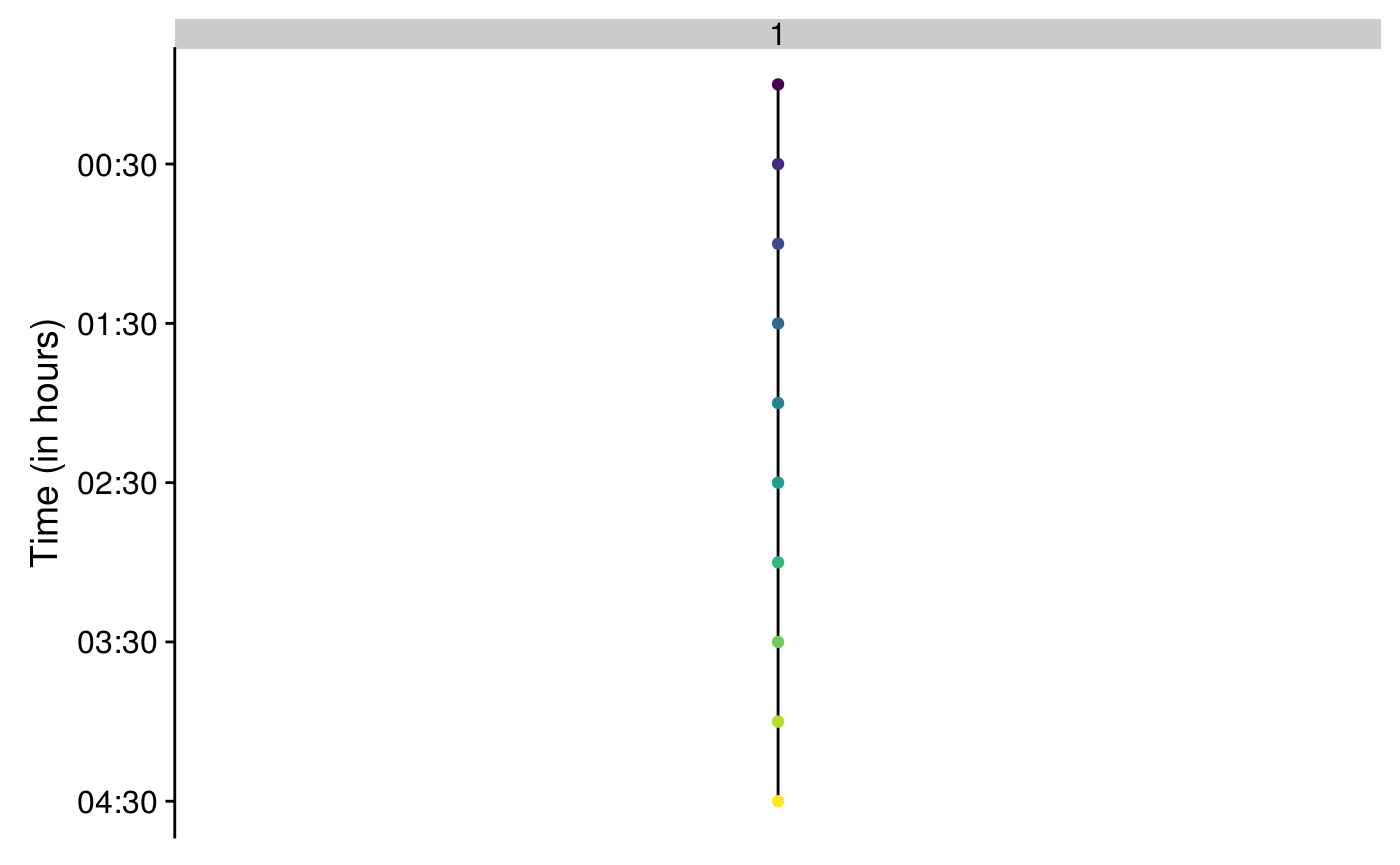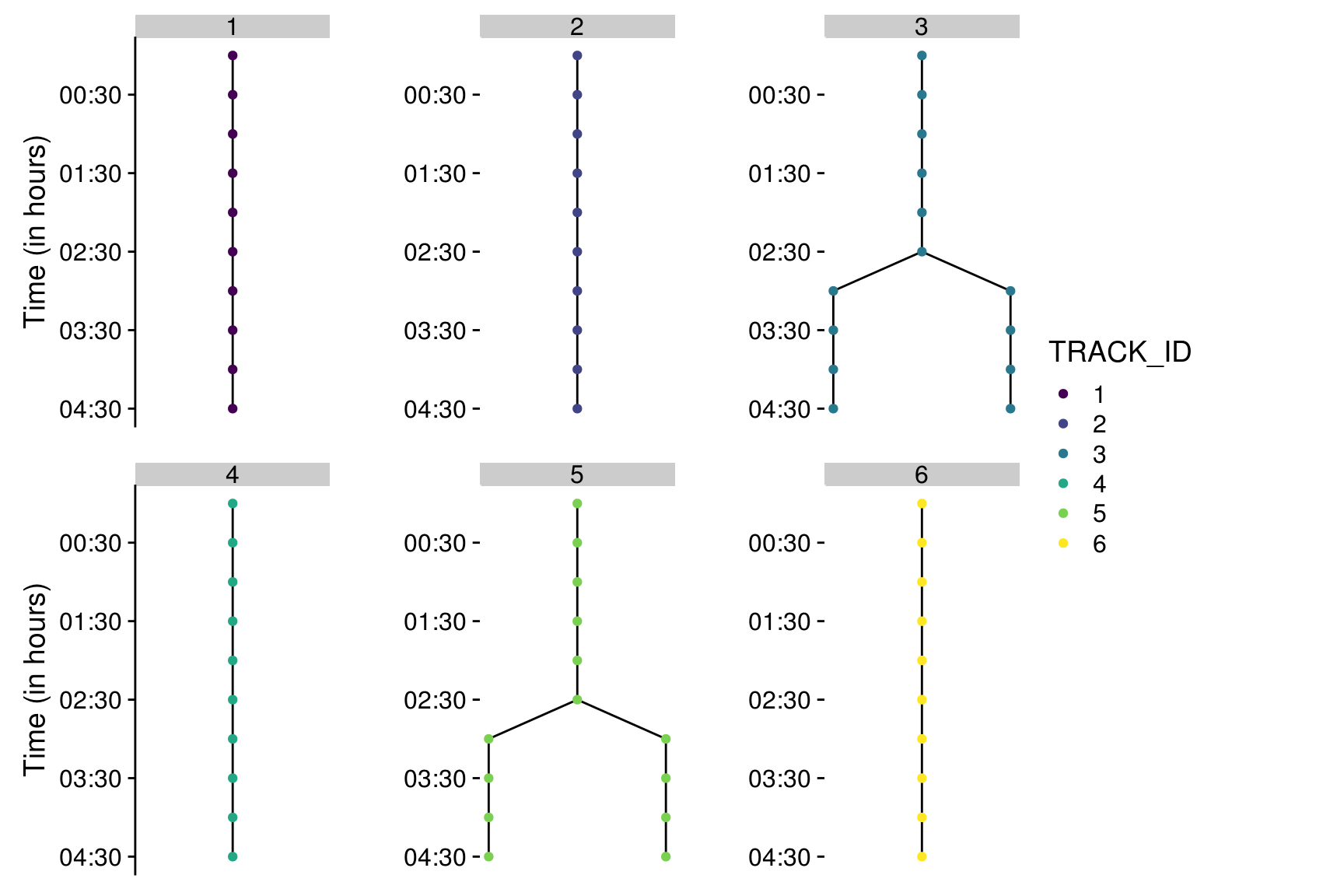The goal of {mamut2r} is to imports data coming from .xml files generated with the Fiji MaMuT plugin for lineage and tracking of biological objects. {mamut2r} also allows to create lineage plots.
How to cite
To cite {mamut2r}, call the R built-in command citation("mamut2r").
Marion Louveaux, & Sébastien Rochette. (2018, October 19). mamut2r: a R package to import and visualize xml files from the MaMuT Fiji plugin (Version v0.0.2). Zenodo. http://doi.org/10.5281/zenodo.1467431
Installation
{mamut2r} is only available on Github.
You may need to install dependencies before:
# rhdf5 (>= 2.24.0) on bioconductor is required
install.packages("BiocManager")
BiocManager::install("rhdf5", update = FALSE)
# Other packages on CRAN
to_install <- c("classInt", "cowplot", "dplyr", "ggplot2", "ggraph", "ggridges", "glue", "grDevices", "igraph", "knitr", "magrittr", "pkgdown", "purrr", "rhdf5", "rmarkdown", "stats", "tibble", "tidyr", "utils", "viridis", "XML", "xml2")
for (i in to_install) {
message(paste("looking for ", i))
if (!requireNamespace(i)) {
message(paste(" installing", i))
install.packages(i)
}
}For Linux and MacOS To install {ggraph}, you will need “udunits”.
- Ubuntu:
sudo apt-get install --yes libudunits2-dev- MacOS:
brew install udunitsFull documentation with {pkgdown}
See full documentation created with {pkgdown} at https://marionlouveaux.github.io/mamut2r/
Open Rmd files used to build vignettes
You may need to install {cellviz3d}, and you will need to install mamut2r with the vignettes.
devtools::install_github("marionlouveaux/cellviz3d")
devtools::install_github("marionlouveaux/mamut2r", build_vignettes = TRUE)
file.edit(system.file(file.path("doc", "vignette_fluo.Rmd"), package = "mamut2r"))
file.edit(system.file(file.path("doc", "vignette_getting_started.Rmd"), package = "mamut2r"))Getting started
Loading .xml MaMuT file
The mamut.xml file is loaded as a list in R using the xmlToList() function from the {XML} package.
Getting information relative to either nuclei (= spots) or lineages (=tracks)
The MaMuT .xml file stores two type of objects, under two types of tags: the spots and the tracks. In the case of the study of the development of an organ, spots usually refer to nuclei and tracks to cell lineages. Here, Spots.as.dataframe() and Tracks.as.dataframe() extract information from the .xml file and format them as dataframes (more precisely as tibbles).
Information regarding the spots (x, y, z location, ID…) are extracted using the Spots.as.dataframe and stored in a tibble.
Spots_df <- Spots.as.dataframe(fileXML)
Spots_df
#> # A tibble: 441 x 11
#> ID name VISIBILITY RADIUS QUALITY SOURCE_ID POSITION_T POSITION_X
#> <int> <chr> <chr> <dbl> <chr> <chr> <dbl> <dbl>
#> 1 2115 ID21… 1 14.6 -1.0 0 0 834.
#> 2 3077 ID30… 1 14.6 -1.0 0 0 788.
#> 3 1542 ID15… 1 14.6 -1.0 0 0 865.
#> 4 3398 ID33… 1 14.6 -1.0 0 0 945.
#> 5 2569 ID25… 1 14.6 -1.0 0 0 888.
#> 6 1930 ID19… 1 14.6 -1.0 0 0 836.
#> 7 2956 ID29… 1 14.6 -1.0 0 0 788.
#> 8 3597 ID35… 1 14.6 -1.0 0 0 1086.
#> 9 337 ID337 1 14.6 -1.0 0 0 1046.
#> 10 3025 ID30… 1 14.6 -1.0 0 0 817.
#> # ... with 431 more rows, and 3 more variables: POSITION_Y <dbl>,
#> # FRAME <chr>, POSITION_Z <dbl>Information regarding the tracks (ID of source and target spots, track ID…) are extracted using the Tracks.as.dataframe and stored in a tibble.
Tracks_df <- Tracks.as.dataframe(fileXML)
Tracks_df
#> # A tibble: 400 x 8
#> SPOT_SOURCE_ID SPOT_TARGET_ID LINK_COST VELOCITY DISPLACEMENT TRACK_NAME
#> <int> <int> <chr> <dbl> <dbl> <chr>
#> 1 135 142 103.6346… 5.81 5.81 Track_1
#> 2 179 182 -1.0 18.6 18.6 Track_1
#> 3 183 184 -1.0 14.6 14.6 Track_1
#> 4 182 183 -1.0 14.6 14.6 Track_1
#> 5 142 179 -1.0 7.20 7.20 Track_1
#> 6 122 129 29.60479… 4.11 4.11 Track_1
#> 7 96 116 42.20738… 2.55 2.55 Track_1
#> 8 116 122 52.23397… 5.70 5.70 Track_1
#> 9 129 135 30.78595… 3.60 3.60 Track_1
#> 10 215 222 56.26781… 14.7 14.7 Track_2
#> # ... with 390 more rows, and 2 more variables: TRACK_ID <chr>,
#> # TRACK_INDEX <chr>Checking tracks
Tracks are composed of nodes (the spots) and edges (between the spots). Source and target spots are respectively the origin and the end of an edge between two timepoints. checkTrack() checks the orientation of edges and ensure to always have the source spot in an earlier timepoint than the target spot. This is necessary for plotting the lineage trees afterwards with {ggraph}.
Tracks_df <- checkTrack(Tracks_df, Spots_df)
Tracks_df
#> # A tibble: 400 x 10
#> SPOT_SOURCE_ID SPOT_TARGET_ID LINK_COST VELOCITY DISPLACEMENT TRACK_NAME
#> <int> <int> <chr> <dbl> <dbl> <chr>
#> 1 135 142 103.6346… 5.81 5.81 Track_1
#> 2 179 182 -1.0 18.6 18.6 Track_1
#> 3 183 184 -1.0 14.6 14.6 Track_1
#> 4 182 183 -1.0 14.6 14.6 Track_1
#> 5 142 179 -1.0 7.20 7.20 Track_1
#> 6 122 129 29.60479… 4.11 4.11 Track_1
#> 7 96 116 42.20738… 2.55 2.55 Track_1
#> 8 116 122 52.23397… 5.70 5.70 Track_1
#> 9 129 135 30.78595… 3.60 3.60 Track_1
#> 10 215 222 56.26781… 14.7 14.7 Track_2
#> # ... with 390 more rows, and 4 more variables: TRACK_ID <chr>,
#> # TRACK_INDEX <chr>, SPOT_SOURCE_FRAME <dbl>, SPOT_TARGET_FRAME <dbl>Merging spots and tracks information
Spots dataframes can be enriched with information coming from the tracks using spots.and.tracks().
Spots_Tracks <- spots.and.tracks(Spots_df, Tracks_df)
Spots_Tracks
#> # A tibble: 441 x 12
#> ID name VISIBILITY RADIUS QUALITY SOURCE_ID POSITION_T POSITION_X
#> <int> <chr> <chr> <dbl> <chr> <chr> <dbl> <dbl>
#> 1 2115 ID21… 1 14.6 -1.0 0 0 834.
#> 2 3077 ID30… 1 14.6 -1.0 0 0 788.
#> 3 1542 ID15… 1 14.6 -1.0 0 0 865.
#> 4 3398 ID33… 1 14.6 -1.0 0 0 945.
#> 5 2569 ID25… 1 14.6 -1.0 0 0 888.
#> 6 1930 ID19… 1 14.6 -1.0 0 0 836.
#> 7 2956 ID29… 1 14.6 -1.0 0 0 788.
#> 8 3597 ID35… 1 14.6 -1.0 0 0 1086.
#> 9 337 ID337 1 14.6 -1.0 0 0 1046.
#> 10 3025 ID30… 1 14.6 -1.0 0 0 817.
#> # ... with 431 more rows, and 4 more variables: POSITION_Y <dbl>,
#> # FRAME <chr>, POSITION_Z <dbl>, TRACK_ID <chr>Visualising the lineage trees
track2plot() allows to plot the lineage trees with a custom color code.
Tracks are identified by their ID.
To plot one track:
track2plot(track = "1", Tracks_df, Spots_Tracks,
colNode = FRAME, colYaxis = "black", colNode_discrete = TRUE)
To plot the first six tracks:
trackset <- all_tracks[1:6]
nbrow <- 2
#display y axis only for plots on the left
colYaxis_pattern <- rep(c("black",
rep("white", (ceiling(length(trackset)/nbrow)-1) ) ), nbrow)
colYaxis <- colYaxis_pattern[1:length(trackset)]
all_layouts <- map2(trackset, colYaxis,
~track2plot(.x, Tracks_df, Spots_Tracks, colNode = TRACK_ID, colYaxis = .y, colNode_discrete=TRUE, breaks = unique(trackset)))
prow <- plot_grid(plotlist = all_layouts, nrow = nbrow)
legend <- get_legend(all_layouts[[1]]+theme(legend.position="right"))
p <- plot_grid( prow, legend, rel_widths = c(1, .3))
p
Acknowledgements
Many thanks to Dr. Jean-Yves Tinevez, John Bogovic, and Dr. Tobias Pietsch for their help on MaMuT and Big Data Viewer, and to Dr. Mike Smith for his help on the getFluo() function.
Code of conduct
Please note that the ‘mamut2r’ project is released with a Contributor Code of Conduct. By contributing to this project, you agree to abide by its terms.